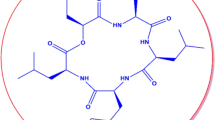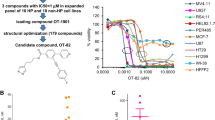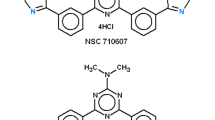Abstract
Purpose
Largazole is a potent class I-selective HDACi natural product isolated from the marine cyanobacteria Symploca sp. The purpose of this study was to test synthetic analogs of Largazole to identify potential scaffold structural modifications that would improve the drug-like properties of this clinically relevant natural product.
Methods
The impact of Largazole scaffold replacements on in vitro growth inhibition, cell cycle arrest, induction of apoptosis, pharmacokinetic properties, and in vivo activity using a xenograft model was investigated.
Results
In vitro studies in colon, lung, and pancreatic cancer cell lines showed that pyridyl-substituted Largazole analogs had low-nanomolar/high-picomolar antiproliferative activity, and induced apoptosis and cell cycle arrest at concentrations equivalent to or lower than the parent compound Largazole. Using IV bolus delivery at 5 mg/kg, two compartmental pharmacokinetic modeling on the peptide isostere analog of Largazole indicated improved pharmacokinetic parameters. In an A549 non-small cell lung carcinoma xenograft model using a dosage of 5 mg/kg administered intraperitoneally every other day, Largazole, Largazole thiol, and Largazole peptide isostere demonstrated tumor growth inhibition (TGI %) of 32, 44, and 66 %, respectively. Largazole peptide isostere treatment was statistically superior to control (p = 0.002) and to Largazole (p = 0.006). Surprisingly, tumor growth inhibition was not observed with the potent pyridyl-based analogs.
Conclusions
These results establish that replacing the depsipeptide linkage in Largazole with an amide may impart pharmacokinetic and therapeutic advantage and that alternative prodrug forms of Largazole are feasible.





Similar content being viewed by others
References
Wagner JM, Hackanson B, Lübbert M, Jung M (2010) Histone deacetylase (HDAC) inhibitors in recent clinical trials for cancer therapy. Clin Epigenetics 1:117–136
Woo S, Gardner ER, Chen X, Ockers SB, Baum CE, Sissung TM et al (2009) Population pharmacokinetics of romidepsin in patients with cutaneous T-cell lymphoma and relapsed peripheral T-cell lymphoma. Clin Cancer Res 15:1496–1503
Subramanian S, Bates SE, Wright JJ, Espinoza-Delgado I, Piekarz RL (2010) Clinical toxicities of histone deacetylase inhibitors. Pharmaceuticals 3:2751–2767
Ververis K, Hiong A, Karagiannis TC, Licciardi PV (2013) Histone deacetylase inhibitors (HDACIs): multitargeted anticancer agents. Biologics 7:47–60
Lobera M, Madauss KP, Pohlhaus DT, Wright QG, Trocha M, Schmidt DR et al (2013) Selective class IIa histone deacetylase inhibition via a nonchelating zinc-binding group. Nat Chem Biol 9:319–325
Marks PA (2007) Discovery and development of SAHA as an anticancer agent. Oncogene 26:1351–1356
Crisanti MC, Wallace AF, Kapoor V, Vandermeers F, Dowling ML, Pereira LP et al (2009) The HDAC inhibitor panobinostat (LBH589) inhibits mesothelioma and lung cancer cells in vitro and in vivo with particular efficacy for small cell lung cancer. Mol Cancer Ther 8:2221–2231
Richardson PG, Schlossman RL, Alsina M, Weber DM, Coutre SE, Gasparetto C et al (2013) PANORAMA 2: panobinostat in combination with bortezomib and dexamethasone in patients with relapsed and bortezomib-refractory myeloma. Blood 122:2331–2337
Bradner JE, West N, Grachan ML, Greenberg EF, Haggarty SJ, Warnow T et al (2010) Chemical phylogenetics of histone deacetylases. Nat Chem Biol 6:238–243
Khan N, Jeffers M, Kumar S, Hackett C, Boldog F, Khramtsov N et al (2008) Determination of the class and isoform selectivity of small-molecule histone deacetylase inhibitors. Biochem J 409:581–589
Taori K, Paul V, Luesch H (2008) Structure and activity of largazole, a potent antiproliferative agent from the Floridian marine Cyanobacterium Symploca sp. J Am Chem Soc 130:1806–1807
Bowers A, West N, Taunton J, Schreiber SL, Bradner JE, Williams RM (2008) Total synthesis and biological mode of action of largazole: a potent class I histone deacetylase inhibitor. J Am Chem Soc 130:11219–11222
Ying Y, Taori K, Kim H, Hong J (2008) Total synthesis and molecular target of largazole, a histone deacetylase inhibitor. J Am Chem Soc 4:1–5
Benelkebir H, Marie S, Hayden AL, Lyle J, Loadman PM, Crabb SJ et al (2011) Total synthesis of largazole and analogues: HDAC inhibition, antiproliferative activity and metabolic stability. Bioorg Med Chem 19:3650–3658
Cole KE, Dowling DP, Boone MA, Phillips AJ, Christianson DW (2011) Structural basis of the antiproliferative activity of largazole, a depsipeptide inhibitor of the histone deacetylases. J Am Chem Soc 133:12474–12477
Bowers AA, Greshock TJ, West N, Estiu G, Stuart L, Wiest O et al (2009) Synthesis and conformation-activity relationships of the peptide isosteres of FK228 and largazole. J Am Chem Soc 131:2900–2905
Bowers AA, West N, Newkirk TL, Troutman-youngman AE, Schreiber SL, Wiest O et al (2009) Synthesis and HDAC inhibitory activity of largazole analogs: alteration of the zinc-binding domain and macrocyclic scaffold. Org Lett 11:1301–1304
Liu Y, Salvador LA, Byeon S, Ying Y, Kwan JC, Law BK et al (2010) Anticolon cancer activity of largazole, a marine-derived tunable histone deacetylase inhibitor. J Pharmacol Exp Ther 335:351–361
Guerra-Bubb JM, Bowers AA, Smith WB, Paranal R, Estiu G, Wiest O et al (2013) Synthesis and HDAC inhibitory activity of isosteric thiazoline-oxazole largazole analogs. Bioorg Med Chem 23:6025–6028
Labonte MJ, Wilson PM, Fazzone W, Russell J, Louie SG, El-khoueiry A et al (2012) The dual EGFR/HER2 inhibitor lapatinib synergistically enhances the antitumor activity of the histone deacetylase inhibitor panobinostat in colorectal cancer models. Cancer Res 71:3635–3648
Nassar A-EF, Kamel AM, Clarimont C (2005) Improving the decision-making process in the structural modification of drug candidates: enhancing metabolic stability. Drug Discov Today 9:1020–1028
Robey RW, Zhan Z, Piekarz RL, Kayastha GL, Fojo T, Bates SE (2006) Increased MDR1 expression in normal and malignant peripheral blood mononuclear cells obtained from patients receiving depsipeptide (FR901228, FK228, NSC630176). Clin Cancer Res 12:1547–1555
Xiao JJ, Foraker AB, Swaan PW, Liu S, Huang Y, Dai Z et al (2005) Efflux of depsipeptide FK228 (FR901228, NSC-630176) Is mediated by P-Glycoprotein and multidrug resistance-associated protein 1. J Pharmacol Exp Ther 313:268–276
Beckers T, Burkhardt C, Wieland H, Gimmnich P, Ciossek T, Maier T et al (2007) Distinct pharmacological properties of second generation HDAC inhibitors with the benzamide or hydroxamate head group. Int J Cancer 121:1138–1148
Fournel M, Bonfils C, Hou Y, Yan PT, Trachy-Bourget M-C, Kalita A et al (2008) MGCD0103, a novel isotype-selective histone deacetylase inhibitor, has broad spectrum antitumor activity in vitro and in vivo. Mol Cancer Ther 7:759–768
Acknowledgments
This work was supported by the National Institutes of Health (RO1 CA152314, to R.M.W and J.E.B.). J.E.B. acknowledges support by Grants from the National Cancer Institute (1K08CA128972) and the Burroughs-Wellcome Foundation (CAMS). JLP acknowledges support from the State of Colorado Bioscience Development Program Grant. This work was also supported by University of Colorado Cancer Center Shared Resource (Pharmacology) support Grant (P30CA046934).
Conflict of interest
J.L.P. and R.M.W. are co-founders of Cetya Therapeutics, Inc.
Author information
Authors and Affiliations
Corresponding author
Electronic supplementary material
Below is the link to the electronic supplementary material.
280_2015_2675_MOESM2_ESM.docx
Plasma time-concentration curves for largazole and largazole peptide isostere. There was a significant difference between the curves as assessed by 2-way ANOVA (p = 0.0121). Error bars indicate standard deviation of the mean (DOCX 82 kb)
Rights and permissions
About this article
Cite this article
Pilon, J.L., Clausen, D.J., Hansen, R.J. et al. Comparative pharmacokinetic properties and antitumor activity of the marine HDACi Largazole and Largazole peptide isostere. Cancer Chemother Pharmacol 75, 671–682 (2015). https://doi.org/10.1007/s00280-015-2675-1
Received:
Accepted:
Published:
Issue Date:
DOI: https://doi.org/10.1007/s00280-015-2675-1




